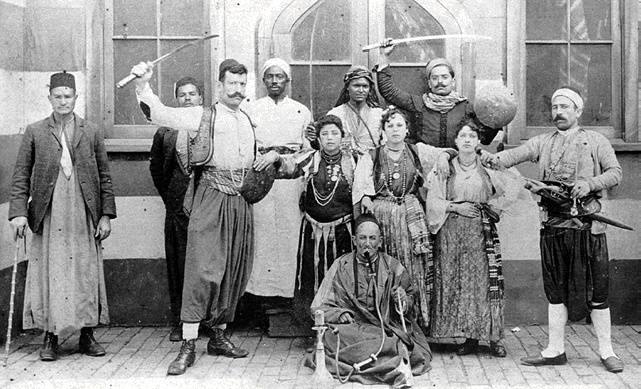Racism at Golden Gate Park's 1894 Midwinter Fair: Difference between revisions
m (changed category from Af-Am to African-American) |
(PC and protected) |
||
| Line 1: | Line 1: | ||
'''<font face = Papyrus> <font color = maroon> <font size = 4>Historical Essay</font></font> </font>''' | |||
''by Mae Silver'' | |||
[[Image:ggpk$midwinter-fair-cairo-pavilion.jpg]] | [[Image:ggpk$midwinter-fair-cairo-pavilion.jpg]] | ||
Revision as of 00:19, 8 January 2009
Historical Essay
by Mae Silver
Cairo Pavilion, Midwinter Fair 1894, Golden Gate Park
Photo: Greg Gaar Collection, San Francisco, CA
Chicago's 1893 Fair commemorating Christopher Columbus' Discovery of America (one year late) was nicknamed "The White City". That title could well have served its sister world's fair, The California Midwinter International Exposition, San Francisco, for the nation's second world's fair in 1894 was actually for white people only. To be sure, there were other "colored" people at the Fair, but they did not enter through the admission gates. The Midwinter Fair, as other popular events of the Victorian Era in San Francisco, contained within it the cultural mindset of its 19th century creators.
The consensus of the era regarded all other peoples than Western European whites as curiosities to be displayed, studied and comprehended. Any level of ethnic, racial sensitivity in that era's thinking was on the brink of social consciousness. Equality as a precept toward all people on the planet was still a long way down the road. At both world's fairs, there were days honoring special events or people. At the Columbian Fair, Frederick Douglass mildly scolded the exposition management for having ignored the American Negro. He made that assessment on Colored Peoples Day, August 25, 1893. On May 2, 1894, the Midwinter Fair celebrated Colored Americans Day. Some black city dwellers took exception to this "needless drawing of the colored line."
Commensurate with the prevailing mindset of the times, black men (women were another whole story) were excluded from the white men's labor movement in the city. That prohibition kept them out of the trade unions which in turn meant they could not erect a building at the Midwinter Fair. The blacks could not show their building talents at the Fair. Oh, yes, there were black men skilled in the building trades back then. The white men's labor movement had formidable problems of its own developing the cohesion among white men to fight for justice in the workplace. The white organizers reasoned not to include black men or women (of any color) at least because neither of these groups had the right to vote and therefore commanded no political clout.
The various ethnic and racial groups on display at the Fair were there for visitors' curiosity and ideally for educational purposes. Along the spectrum of displays, at best these groups would inform. At worst, they were seen as specimens or freaks. A front page story of a local paper read: "Trouble among the Freaks" referring to unhappiness among the Javanese, Arabs and Egyptians at the Fair.
Former California Governor Pio Pico, who served twice at that post, was invited to the Columbian Fair. He indignantly refused fearing he would be on "display". White Americans had at least two strikes against them according to the Governor. It was American law that had validated an American claim to his vast land holdings in Southern California leaving him less than affluent in his old age. Sensing the Gringo mindset of the Fair, the Governor knew his California heritage including Native American, Afro-American, Mexican, and Spanish that produced his Mulatto appearance would make him a good candidate to be gawked at like a geek in Chicago. He would have none of that.
The 1894 Midwinter Fair gave the White American family an opportunity to stand at the threshold of the world, peek in at others, try their foods, watch their cultural rituals, and hopefully move close enough to hear what the rest of the world had to say.
--Mae Silver
Sources:
Barth, Gunther, Instant Cities New Mexico, 1988
Daniels, Douglas Henry Pioneer Urbanites Pa. 1980
San Francisco History Room Archives, Midwinter Fair Files
San Francisco Examiner May 19, 1893; front page

